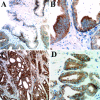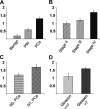Up-regulation of dicer, a component of the MicroRNA machinery, in prostate adenocarcinoma
- PMID: 17071602
- PMCID: PMC1780192
- DOI: 10.2353/ajpath.2006.060480
Up-regulation of dicer, a component of the MicroRNA machinery, in prostate adenocarcinoma
Abstract
MicroRNAs are small noncoding 18- to 24-nt RNAs that are predicted to regulate expression of as many as 30% of protein-encoding genes. In prostate adenocarcinoma, 39 microRNAs are up-regulated, and six microRNAs are down-regulated. Production and function of microRNA requires coordinated processing by proteins of the microRNA machinery. Dicer, an RNase III endonuclease, is an essential component of the microRNA machinery. From a gene array analysis of 16 normal prostate tissue samples, 64 organ-confined, and four metastatic prostate adenocarcinomas, we identified an up-regulation of major components of the microRNA machinery, including Dicer, in metastatic prostate adenocarcinoma. Immunohistochemical studies on a tissue microarray consisting of 232 prostate specimens confirmed up-regulation of Dicer in prostatic intraepithelial neoplasia and in 81% of prostate adenocarcinoma. The increased Dicer level in prostate adenocarcinoma correlated with clinical stage, lymph node status, and Gleason score. Western blot analysis of benign and neoplastic prostate cell lines further confirmed Dicer up-regulation in prostate adenocarcinoma. Dicer up-regulation may explain an almost global increase of microRNA expression in prostate adenocarcinoma. The presence of up-regulated microRNA machinery may predict the susceptibility of prostate adenocarcinoma to RNA interference-based therapy.
Figures





References
-
- Gregory RI, Shiekhattar R. MicroRNA biogenesis and cancer. Cancer Res. 2005;65:3509–3512. - PubMed
-
- Croce CM, Calin GA. miRNAs, cancer, and stem cell division. Cell. 2005;122:6–7. - PubMed
-
- Volinia S, Calin GA, Liu CG, Ambs S, Cimmino A, Petrocca F, Visone R, Iorio M, Roldo C, Ferracin M, Prueitt RL, Yanaihara N, Lanza G, Scarpa A, Vecchione A, Negrini M, Harris CC, Croce CM. A microRNA expression signature of human solid tumors defines cancer gene targets. Proc Natl Acad Sci USA. 2006;103:2257–2261. - PMC - PubMed
-
- Johnson SM, Grosshans H, Shingara J, Byrom M, Jarvis R, Cheng A, Labourier E, Reinert KL, Brown D, Slack FJ. RAS is regulated by the let-7 microRNA family. Cell. 2005;120:635–647. - PubMed
Publication types
MeSH terms
Substances
LinkOut - more resources
Full Text Sources
Other Literature Sources
Medical
Molecular Biology Databases
Research Materials

